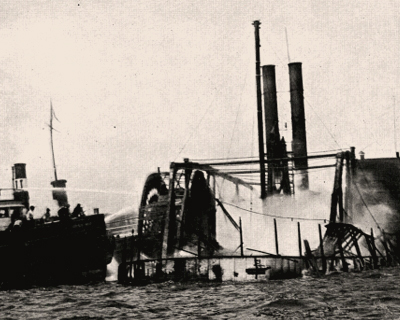Sergei Mikhailovich Prokudin-Gorskii / Wikimedia Commons / CC-BY-SA-3.0 / GFDL
1 – The Trans-Siberian railway was completed
The world’s longest railway was completed on July 21st, 1904.
The original train traveled at approx. 20mph, meaning it took nearly four weeks to complete the journey, but now the journey takes about a week. The line from Moscow to Vladivostok measures 5,772 miles.
The project was officially given the go-ahead by Tsar Alexander III in 1891. Food and supplies for an army of laborers gave rise to massive costs.
The scale of the project saw workers building through never-ending steppes, over rivers, through forests, swamps, and Siberian permafrost, all the while fending off attacks from marauding bandits and tigers.
The first passenger trains ran during the summer of 1903, but a ferry was required to cross Lake Baikal until the track around the lake’s edge was completed. This track weaves its way through thirty-three tunnels and traverses over a hundred bridges and viaducts.
The railroad’s completion opened up vast areas of Siberia for exploitation, settlement, and industrialization.
The railway was primarily intended to develop Russia’s imperial aspirations in the Far East, with the final section built through land leased from the Chinese in Manchuria.
However, after the Russo-Japanese War, a longer line was constructed along the Amur River, making it an all-Russian route. This was finished in 1916.
The Trans-Siberian Railroad, therefore, had two completion dates. The 1904 route ran from Moscow to Vladivostok through Manchuria, while the 1916 route traveled completely within Russian territory.
2 – The General Slocum disaster

The General Slocum, named after a Civil War general, was a passenger steamboat which caught fire and sank in the East River of New York City, on June 15th, 1904.
It was on a chartered run carrying German American members of the Evangelical Lutheran Church to a church picnic. It is estimated 1,021 of the 1,342 passengers died.
It is not known how the fire started, but the fire hoses on board, which were cheap and decayed from age and neglect, broke when activated.
Most of the crew had never been trained in a fire drill, and, instead of helping, pushed passengers out of the way and abandoned ship. The few lifeboats on board were never lowered.
The Slocum and its life preservers had only recently passed inspection, without ever actually being checked.
As it turned out, the life preservers were rotten, filled with dried cork, and some had metal weights added to them to bring their weight specifications up to standard.
Tragically, the women who tossed their children into the water with life preservers on them, watched in horror as they disappeared without ever re-surfacing.
There were many acts of heroism from passengers, witnesses, and emergency personnel, while the North Brother Island hospital staff formed human chains to pull victims from the water.
The boat’s owners, the Knickerbocker Steamship Company, only had to pay a small fine, despite evidence they might have falsified inspection records. They ended up paying nothing to the survivors or the victims’ families.
The ship’s Captain van Schaick, who did not try to ground the ship, was made a scapegoat for the disaster, receiving a ten-year prison sentence, but was pardoned after less than four years.
The families in the neighborhood of Little Germany were decimated, many lost a mother and two or more children, while some entire families were killed.
Over 900 victims were buried in the Lutheran Cemetery, Middle Village, Queens, including 61 in an unidentified mass grave.
Amazingly, two survivors of the disaster lived until the 21st century. Catherine Connelly, who was going on a boat for her first, and last, time, died on October 17th, 2002, aged 109.
Adella Wotherspoon was the last living survivor of the disaster, dying on January 26th, 2004, at the age of 100.
The General Slocum disaster was New York’s worst loss of life until the attacks on the World Trade Centre on September 11th, 2001. It remains the worst maritime disaster in the city’s history.
3 – The Entente Cordiale

The Entente Cordiale was a series of agreements between the United Kingdom and France. Among the most important parts of the agreement, was France recognizing British control of Egypt, while Britain returned the favor to France with regard to Morocco.
The agreement marked the end of almost one thousand years of intermittent conflict between the two superpowers. It was a more formal agreement to replace the ‘modus vivendi’ that came into existence in 1815, at the end of the Napoleonic Wars.
Among the other issues settled in the agreement, France gave up exclusivity to their fishing rights on the French Shore of Newfoundland.
At the same time, the British-owned Los islands off French Guinea was ceded to France, the Nigerian frontier was re-defined in France’s favor and French control of the upper Gambian valley (Senegal) was agreed upon.
The final issues agreed upon saw their respective influences defined in Siam (Thailand), with the British recognizing French influence to the east of the River Menam’s basin, and the French recognizing British influence to the west of the Menam basin.
Britain also acknowledged the French customs régime in Madagascar.
Another result of the agreement meant both countries reduced the virtual isolation they had found themselves in while being at odds over African affairs. The agreement was to cause upset to Germany, as their policy had relied on Franco-British antagonism.
